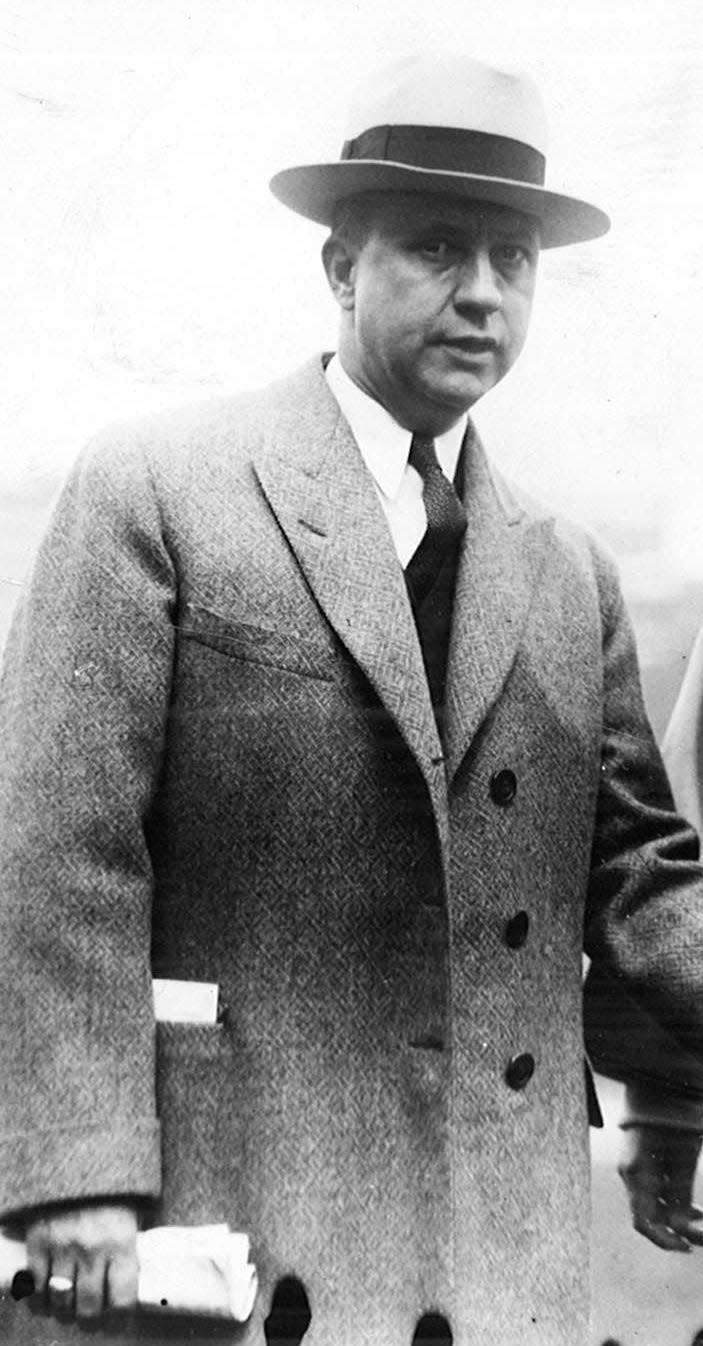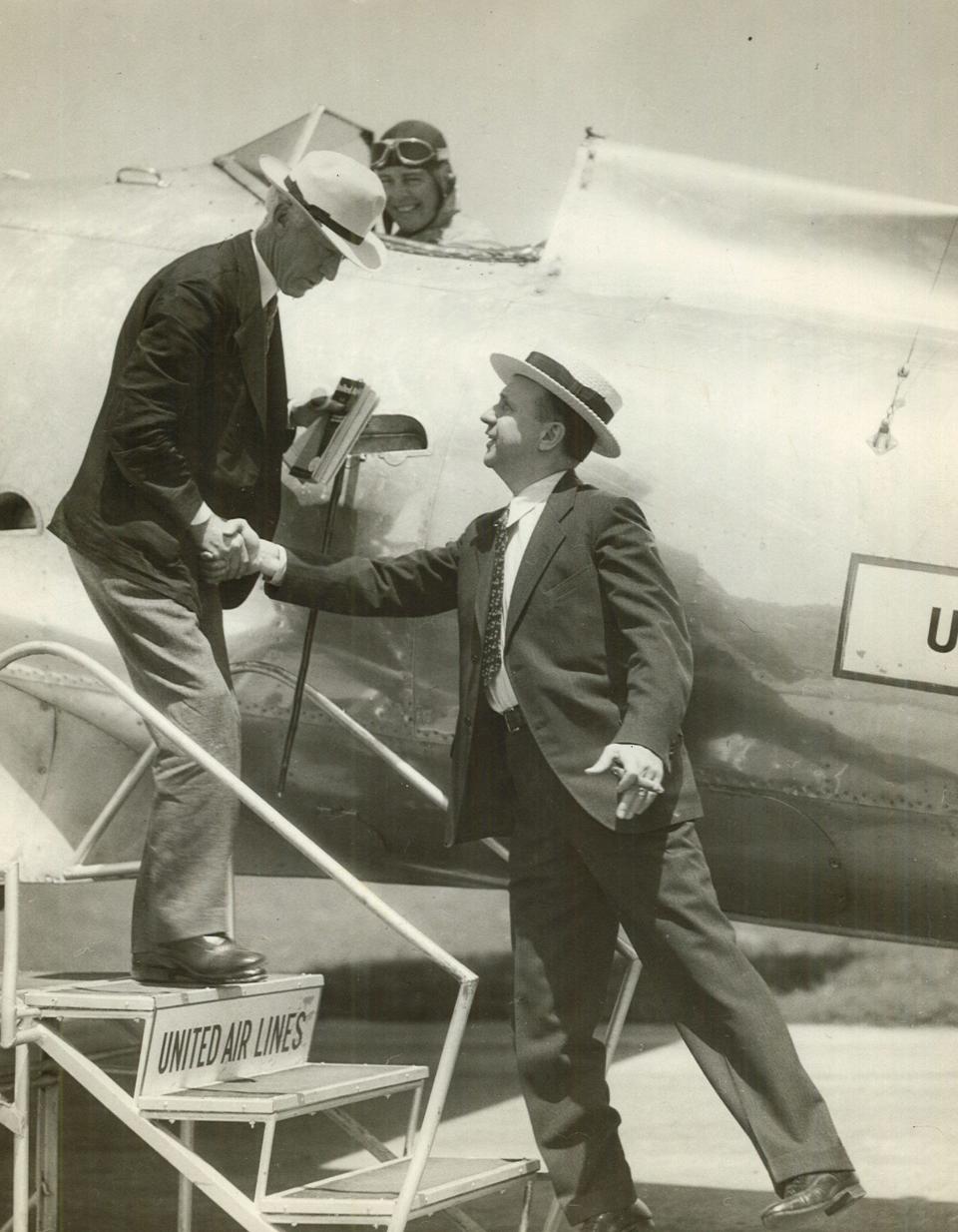Long before Iowa Cubs baseball, Des Moines Demons hosted first professional game under permanent lights
Editor's note: This story by Mike Wellman was originally published April 30, 2015.
At the corner of Sixth and Holcomb avenues in Des Moines there used to be a ballpark on grounds now home to North High School's Grubb Community Stadium. Some references called it Western League Park; others, Holcomb Park.
It wasn't the Field of Dreams, but a plaque there now refers to it as the Field That Saved Baseball. On May 2, 1930, it was the Field of Crossed Fingers.
The minor leagues, like much of America as the Great Depression put a chokehold on the country, were going out of business. Fewer and fewer had the time or money to spend at a ballgame. Beer wasn't a revenue stream for ball clubs during Prohibition. Something had to be done, or a game woven tightly into the American fabric could be lost.
That's when Lee Keyser stepped up to the plate.

Before noted baseball impresarios Bill Veeck (Eddie Gaedel, who at 3-foot-7 is the shortest player to ever get an MLB at-bat; Disco Demolition Night) or Charlie Finley (white shoes and orange baseballs), there was Keyser. Remember him? How about Sec Taylor? Sec Taylor thought a lot of Lee Keyser. After Keyser's death he had this to say in a column that ran in the Des Moines Register on April 27, 1950:
"I expressed this belief while he was living and I write it again now that Lee Keyser is dead — his name should be inscribed in the Baseball Hall of Fame at Cooperstown, N.Y. For he saved minor league baseball during the depression years in the early '30s."
More:
Iowa Cubs to be sold to California-based sports-entertainment firm Endeavor
Michael Gartner on selling the Iowa Cubs: 'I'm just going to enjoy the games the way I used to'
Alas, enter his name in the search bar at the Hall of Fame website and Keyser comes up hitless.

In 1930, Keyser was an owner of the Class B Des Moines Demons. After the 1929 season he pushed all of his chips to the middle of the table when he announced his intention to put up lights at Holcomb Park and play ball at night.
Imagine — Des Moines lit up before Las Vegas did! Maybe Keyser heard a voice whispering, "If you light it, they will come." During that offseason, Keyser installed stanchions engineered by General Electric at a reported cost of $22,000, more than it had cost to build the spartan ballyard in 1914.
In 1988, when the chronically behind Chicago Cubs finally illuminated Wrigley Field (which opened the same year as Holcomb Park), becoming the last major league franchise to add lights, it was a very big deal. In 1930, a commensurate amount of glare was directed at Sixth and Holcomb.
More: 13 beautiful photos of Principal Park, home of Iowa Cubs
Somehow a crowd that was more than double the listed capacity of 5,000 squeezed in. In lieu of skybox suites, men in suits and fedoras sat on the ground along the foul lines and formed a human warning track in front of the outfield walls, partially obscuring advertisements that decorated them.
The commissioner of baseball, Kenesaw Mountain Landis, was in town. So was NBC Radio; the game time was pushed back to accommodate the network, an early kowtow by baseball to the broadcast media. As a result the game didn't end until past midnight.
There was a lot riding on the outcome that had nothing to do with who won, and the final score was a suspenseless formality after the Demons put up 11 runs in the bottom of the first inning and coasted to a 13-6 triumph over the Wichita Aviators. The visitors' southpaw starter, Rufus Meadows, had beaten the Demons not two weeks earlier.

But neither Meadows nor the rest of the Aviators made any errors in the game or blamed their defeat whatsoever on low visibility. All parties agreed that the lights had played well.
Within a month similar systems were installed at Omaha and Decatur. By that summer's end the switch had flipped in 38 ballparks.
OK, so the lights at Holcomb Park were only a reprieve locally. After the 1937 season the Demons went belly-up, beginning a decade without pro baseball here, the longest stretch without it since Des Moines first got into the game in the late 19th century. But nocturnal game times saved the day for the minor leagues collectively.
More: A change to the batter's eye, video screen and more. Big changes possibly coming to Principal Park
The Holcomb light towers were moved to a World War II ordnance plant in Ankeny so ammunition could be cranked out around the clock, and the grandstands were dismantled after an auction in 1945 when the school board, which owned the land, sold the wooden seats and their steel framework to a construction company.
Principal Park, nee Sec Taylor Stadium, nee Pioneer Park, opened in 1947 as the home of the Des Moines Bruins and one team has led to another in Des Moines ever since, except for another delay of games between 1962 and 1968.
The only discouraging words in the immediate aftermath of the 1930 game concerned the scoreboard, modest by today's spectacular standards. Before the game was over Keyser had promised to add the finishing touch of some reflectors that would better illuminate the numbers and they were installed the next morning.
Nearly 90 years later the Iowa Cubs have a 64-foot-by-24-foot high-definition magic window; the state-of-the-art video board vividly elaborates on the live action.
With all due respect to I-Cubs general manager Sam Bernabe, were it not for Lee Keyser there might never have been a ballpark for Bernabe to go to work at more than 30 years ago and eventually come all the way around to score as a part-owner of one of the most stable franchises in Triple-A baseball. And he knows it.
"In our business names don't get any bigger than Lee Keyser," Bernabe said while standing in the concourse on 2015's opening night watching the turnstiles whir. Lines were forming at the concession stands and the ATMs, and the first pitch was still more than half an hour away.
"Fifteen years ago we did a promotion on the 70th anniversary of that historic game," Bernabe recalled. "Musco Lighting (the Iowa firm that's been an industry leader since 1976) was here, and we shut down the regular lights so they could relight the ballpark at the same candlepower Keyser installed in 1930. It seemed dark by comparison."
More: 'Business as usual': What MLB's lockout means for Iowa's three minor league teams
That dazzling new video board that Bernabe has to play with this year? "We haven't even turned it up to full power yet," he said, smiling. Even at 75 percent, it's impressive.
That opening night crowd downtown swelled to more than 12,000, about the size of the one at Sixth and Holcomb on May 2, 1930. It was the biggest one the I-Cubs have ever drawn in the month of April. The ballpark made for a nice vantage point on a beautiful night to scan the skyline at dusk and take a whiff of the breeze coming off the river mixing with the one coming off the stadium grills.
Maybe Lee Keyser was tossing and turning in his grave that night. The postgame fireworks show was loud and bright enough to wake the dead.
About the Des Moines Demons
Who were those Demons that history so dramatically, if briefly, brought to light? The Register playfully called them the "Imps" sometimes in headlines, like the Pittsburgh Pirates are called the Bucs.
Al Van Camp hit .343 that year. Was his nickname "Beans"? Stan (The Man?) Keyes was the star slugger. He got four hits that momentous night. In 1931 he won the Western League Triple Crown, the highlight of a long career that didn't end until he was 41 — still toiling away at Class B — in 1940. Buckshot May was a so-so pitcher with a great moniker.
Then there was Les Cox. He must have been a favorite target of the bench jockeys around the league. Bud Tinning was the winning pitcher on May 2, 1930. The next year he went 24-2 in the Western League and eventually logged some seasons in the big leagues with the Cubs.
This article originally appeared on Des Moines Register: Iowa's Lee Keyser was behind first baseball game under stadium lights

